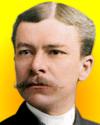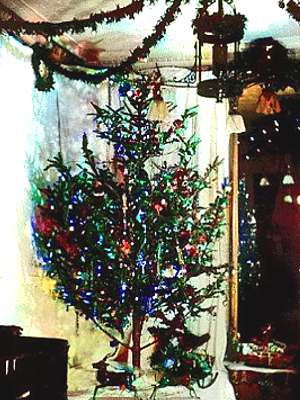 (source)
(source)
|
Edward H. Johnson
(4 Jan 1846 - 9 Sep 1917)
American electrical engineer and inventor who spent many years in various business projects with Thomas Edison, including being the vice-president of the Edison Electric Light Company.
|

IN AND ABOUT THE CITY
A BRILLIANT CHRISTMAS TREE.
How an Electrician Amused His Children.
from an article in the New York Times (1884)
A pretty as well as novel Christmas tree was shown to a few friends by Mr. E. H. Johnson, President of the Edison Company for Electric Lighting, last evening in his residence, No. 139 East Thirty-sixth-street. The tree was lighted by electricity, and children never beheld a brighter tree or one more highly colored than the children of Mr. Johnson when the current was turned and the the tree began to revolve. Mr. Johnson has been experimenting with house lighting by electricity for some time past, and he determined that his children should have a novel Christmas tree.
It stood about six feet high, in an upper room, last evening, and dazzled persons entering the room. There were 120 lights on the tree, with globes of different colors, while the light tinsel work and usual adornment of Christmas trees appeared to their best advantage in illuminating the tree. Mr. Johnson had placed a little Edison dynamo at the foot of the tree, which, by passing a current through from the large dynamo in the cellar of the house, converted it into a motor. By means of this motor the tree was made to revolve with a steady, regular motion. The lights were divided into six sets, one set of which was lighted at a time in front as the tree went round. By a simple devise of breaking and making connection through copper bands around the tree with corresponding buttons, the sets of lights were turned out and on at regular intervals as the tree turned around. The first combination was of pure white light, then, as the revolving tree severed the connection of the current that supplied it and made connection with a second set, red and white lights appeared. Then came yellow and white and other colors. Even combinations of the colors were made. By dividing the current from the large dynamo, Mr. Johnson could stop the motion of the tree without putting out the lights.
The mechanism by which the shifting of the lights is made has been patented by Mr. Johnson, who believes that its use will be invaluable in scenic effects. The changes can be made with clockwork regularity, while the field for combinations and effects is almost unlimited. There is no house in the city in which electrical lighting is put to more novel uses than in Mr. Johnson's. As one enters the parlor a bright grate fire attracts attention. On examination the discovery is made that it is of colored paper, which is never consumed, but under which electric lights are hidden. The brilliancy of the effect of the painting on a porcelain urn surprises the visitor. Inside the jar is an electric light. The brightness of the chandeliers and brackets is emphasized by means of the electric lights.
The house is the first in the city in which electric lights were supplied from a current generated in an isolated plant. The dynamo is in the cellar and makes so little noise that it can not be heard on the floor above. A small engine supplies the dynamo, and the steam after running the dynamo is used in heating the house. Mr. Johnson's experiments have proved most satisfactory in almost every respect and he has promised to make a connection with one or two of his neighbor's houses that they may also be lighted with electricity.
- 4 Jan - short biography, births, deaths and events on date of Johnson's birth.
- The First Electric Christmas Tree Lights - from Detroit Post and Tribune (1882).
- 22 Dec 1882 - event description for creation of the first string of electric Christmas tree lights.
- Stories Behind the Great Traditions of Christmas, by Ace Collins. - book suggestion.





